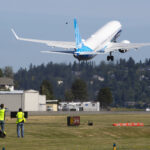Profitable performance of its Auto and Group stop-loss medical insurance lines drove Safeco’s second-quarter results as the company reported net income of $111.9 million, or $0.81 per diluted share. This compares with net income of $105.2 million, or $0.82 per share, in the second quarter of last year.
Operating earnings more than doubled, climbing to $97.2 million in the quarter compared with $43.2 million for the same period last year. Operating earnings is a non-GAAP measure that reflects the performance of Safeco’s business lines since it excludes the effects of net realized investment gains and losses.
“We continue to be pleased with our progress,” said Mike McGavick, Safeco chairman and CEO. “Considering the magnitude of claims from devastating tornadoes and hailstorms, our results show just how much progress we’ve made.
“Our Auto insurance line produced its first profitable quarter in almost two years,” he added. “And our stop-loss medical line continues to exceed our expectations.”
As previously announced, Safeco’s insurance customers were hit hard by catastrophic storms in the second quarter. Claims from catastrophe losses reached $99.1 million pretax, including $60.5 million in Homeowners, $22.3 million in Auto, $14.3 million in business insurance and $2.0 million for all other lines. This compares with a total of $64.8 million in catastrophe losses for the second quarter of last year.
Safeco’s return on equity for the first half of the year, based on annualized net income, was 9.2 percent. Operating return on equity, measured using annualized operating earnings and excluding unrealized gains, was 13.4 percent for the first six months of 2003.
The company realized net investment gains of $14.7 million after tax in the quarter, down from $62.0 million for the same period last year. Safeco recorded $30.3 million after tax for impaired investments during the second quarter. These impairments were more than offset by gains on securities transactions.
Overall revenues increased to $1.9 billion, up 4.0 percent compared to the second quarter of last year. Operating revenues – excluding net realized investment gains – grew 8.6 percent.
“We’ve addressed most of the fundamental issues previously facing Safeco,” McGavick noted. “The one nagging challenge that remains is bringing our expenses in line with our best competitors.’ As we begin developing 2004 business plans, I’m asking everyone in the company to become even more expense-conscious. We should constantly ask ourselves, ‘If this were my money, would I spend it this way?'”
Net earned premiums for all Property & Casualty operations increased 7.1 percent compared with the second quarter of 2002. Net written premiums, a leading indicator of revenues in future quarters, increased 11.2 percent.
Safeco Personal Insurance Performance
Personal Auto, Safeco’s largest product line, generated a pretax underwriting profit of $3.3 million, its first profitable performance since the third quarter of 2001. This compares with a loss of $7.3 million in the second quarter of 2002.
The line produced a combined ratio of 99.4, an improvement over both 100.3 in the first quarter of this year and 101.6 in the second quarter of last year. Combined ratio is a standard gauge of underwriting performance measuring the percentage of premium dollars used for customer claims and expenses. A combined ratio below 100 indicates that the line is operating profitably.
“It’s good to see Auto turn a profit again,” McGavick noted. “While it’s too soon to say this is a trend, the signs are pointing in the right direction.
“Our goal is for Auto to consistently generate combined ratios in the mid- 90s,” he added. “We would have hit that target this quarter if not for the significant amount of storm damage to vehicles. We’re also seeing robust growth in the number of policies sold to the best drivers as well as improved retention.”
Net written Auto premiums increased 17.0 percent compared with the second quarter of 2002. Total number of policies increased 9.6 percent compared with a year ago.
Safeco’s Homeowners line reported a quarterly pretax underwriting loss of $13.4 million, compared with a loss of $36.9 million for the same period last year. Combined ratio was 107.0, better than the 119.5 generated in the second quarter last year, but not as strong as the profitable 89.7 in the first quarter of this year.
“Although the line lost money because of significant catastrophes in the quarter, the underlying fundamentals of our Homeowners line continue to improve,” McGavick said.
Safeco is seeing a change in the way customers use Homeowners insurance to protect their property. Three years ago, nearly half of Safeco’s Homeowners customers purchased policies with a $250 deductible, resulting in numerous small claims for maintenance-related issues. Today, 94 percent of customers have deductibles of $500 or more.
“While Homeowners is improving, we’re still not getting adequate rate in every market,” McGavick noted. “We have moratoriums on selling new Homeowners policies in seven states, most recently California.
“We continue rolling out our new Homeowners product, which is now available in 31 states,” he added. “In this quarter’s results, we saw early indications that the product more accurately matches rate to the risk we take on.”
Net written premiums in Homeowners increased 0.8 percent compared to the second quarter of last year. The number of policies decreased 9.1 percent compared with the same period of 2002.
Contributing to the overall performance of Safeco Personal Insurance was a $14.8 million pretax underwriting profit in Specialty Lines, up $11.8 million compared with the second quarter last year. This is the result of increased rates, lower losses and the favorable settlement of prior-quarter claims.
Safeco Business Insurance Performance
Safeco Business Insurance reported a pretax underwriting loss of $21.5 million in the second quarter, an improvement over a $41.2 million loss in the same period last year. Combined ratio was 106.0, better than the 111.1 in the second quarter of 2002, but not as strong as the 101.5 reported in the first quarter of this year.
SBI Regular – Safeco’s core line of products for small- to medium-sized businesses – reported a combined ratio of 104.2 in the quarter. While the performance is better than the 109.9 in the second quarter of last year, it’s off from 102.0 in the first quarter of 2003 because of weather and catastrophe claims.
Expenses in Safeco’s commercial insurance lines remain high as a result of several factors, including an increase in agent bonus commission costs during the second quarter and costs associated with automation.
In the first quarter, Safeco rolled out an automated system for selling Business Owners Policies – a comprehensive package of insurance products tailored for small businesses. This contributed to a 35.7 percent increase in new accounts in the first half of this year compared with the same period last year.
Second quarter product-development efforts focused on adding commercial automobile insurance to this automated system. The new feature was launched last week and is expected to take four months to roll out nationwide. Workers’ compensation insurance will be added to the automated platform in the fall, followed by commercial multi-peril insurance next year.
“We expect this system to drive profitable growth, and our costs will decline as we get further along in the rollout,” McGavick noted. “That said, we’re not satisfied with expenses in this line.”
Net written premiums for Safeco Business Insurance increased 9.4 percent in the second quarter compared with the same period in 2002.
Net written premiums for SBI Regular increased 11.0 percent compared to the second quarter of 2002. Despite growth of 16.9 percent in the number of SBI Regular new business policies issued during the quarter, total policies in force decreased 6.9 percent compared to a year ago.
Was this article valuable?
Here are more articles you may enjoy.

 Central US Severe Weather Outbreak Caused Billions in Damages, AccuWeather Says
Central US Severe Weather Outbreak Caused Billions in Damages, AccuWeather Says  Brazil Sues EV Giant BYD Over ‘Slavery’ Conditions at Plant
Brazil Sues EV Giant BYD Over ‘Slavery’ Conditions at Plant  The Vital Role of Claim Professionals After Cyberattacks
The Vital Role of Claim Professionals After Cyberattacks  Boeing Reaches Nonprosecution Deal With US Over 737 Max Crashes
Boeing Reaches Nonprosecution Deal With US Over 737 Max Crashes 